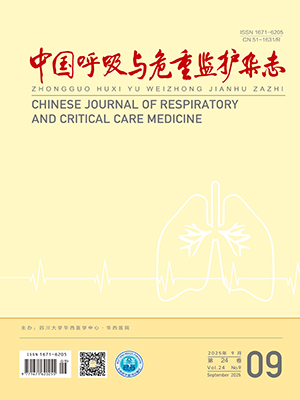| 1. |
Global strategy for asthma management and prevention. Revised 2014. Available at: http://www.ginasthma.org.
|
| 2. |
孙永昌. 哮喘-慢阻肺重叠综合征指南解读. 中国呼吸与危重监护杂志, 2014, 13(4): 325-329.
|
| 3. |
Miravitlles M, Soler-Cataluña JJ, Calle M, et al. A new approach to grading and treating COPD based on clinical phenotypes: summary of the Spanish COPD Guidelines (GesEPOC). Prim Care Respir J, 2013, 22(1): 117-121.
|
| 4. |
中华医学会呼吸病学分会慢性阻塞性肺疾病学组. 慢性阻塞性肺疾病诊治指南(2013 年修订版). 中华结核和呼吸杂志, 2013, 36(4): 255-264.
|
| 5. |
Vignola AM, Rennar SI, Hargreave FE, et al. Standardised methodology of sputum induction and processing: future directions. Eur Respir J, 2002, 20(Suppl 37): 51s-55s.
|
| 6. |
Barrecheguren M, Esquinas C, Miravitlles M. The asthma-chronic obstructive pulmonary disease overlap syndrome (ACOS): opportunities and challenges. Curr Opin Pulm Med, 2015, 21(1): 74-79.
|
| 7. |
Gibson PG, McDonald VM. Asthma-COPD overlap 2015: now we are six. Thorax, 2015, 70(7): 683-691.
|
| 8. |
Menezes AMB, Montes de Oca M, Pérez-Padilla R, et al. Increased risk of exacerbation and hospitalization in subjects with an overlap phenotype: COPD-asthma. Chest, 2014, 145(2): 297-304.
|
| 9. |
Rubio MC, Casamor R, Miravitlles M. Identification and distribution of COPD phenotypes in clinical practice according to Spanish COPD Guidelines: the FENEPOC study. Int J COPD, 2017, 12: 2373-2383.
|
| 10. |
Cosio BG, Soriano JB, Lopez-Campos JL, et al. Defining the asthma-COPD overlap syndrome in a COPD cohort. Chest, 2016, 149(1): 45-52.
|
| 11. |
Jin JM, Liu XF, Sun YC. The prevalence of increased serum IgE and Aspergillus sensitization in patients with COPD and their association with symptoms and lung function. Respir Res, 2014, 15: 130.
|
| 12. |
Tamada T, Sugiura H, Takahashi T, et al. Biomarker-based detection of asthma-COPD overlap syndrome in COPD population. Int J COPD, 2015, 10: 2169-2176.
|




